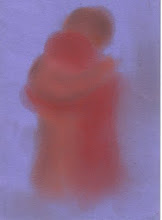
A few weeks ago my therapist noted that I had a very disorganised attachment pattern.
At the time, I wasn’t the least interested in what she was saying and put it down to just the usual psycho mumbo jumbo that abounds in that particular sphere.
I have blogged about this before. It’s the second or third time she has mentioned it in passing. I’d love to have the ... whatever it takes...(guts perhaps?) to have asked her what she meant but at the moment, for reasons that are, quite churlishly, sticking their fingers up whilst urinating up the wall of the logical corner of my brain, I feel as though her kindness is a poisonous solution being drip fed into me. Hence, no questioning the therapist.
However, alone I crumble. And so again, I knelt at the font of Google in search of answers.
What IS a disorganised attachment? And for that matter, what the hell IS attachment? (I saw dozens of brand new Dysons being showcased and demonstrated by men with very white teeth (not sure where that came from) each displaying a technologically ingenious array of attachments).
Anyway. Turned out it has nothing to do with hoovers.
In brief, and I’m not remotely up on psychological theories so, if you know better, feel free to correct me...
There are all different types of attachment but they all concern the relationship between a child and its caregiver (often the mother).
A secure attachment appears to be th 'ideal'. The child's world is hunky dory because the mother is attentive to her baby's needs therefore allowing the child to build a healthy dependency, sense of security and protection.
With me?
Ok. In all honesty...? How many people get that.
The following is information I found on a Canadian website called
AboutKidsHealthDisorganized/disoriented attachment
There is a group of children (15-20%) who do not fit into Ainsworth’s original three-category scheme. Mary Main, another influential attachment researcher, added a fourth category to include these children.
Whereas children in the 3 primary attachment groups have organized strategies for dealing with arousal, disorganized children either lack an organized pattern to their behavior or have strategies that repeatedly break down. When stressed, in the presence of their caregiver, these children appear disorganized or disoriented displaying unusual behaviors such as approaching the caregiver with their head averted, trance-like freezing, or strange postures. These behaviors have been interpreted as evidence of fear or confusion with respect to the caregiver. Disorganization is considered an extreme form of insecurity.
Many children who fall into the disorganized category have experienced some form of maltreatment or have a parent who has been traumatized by severe loss. Other stressful situations involving reorganization of the family such as family moves or the birth of another child may also temporarily disorganize attachment patterns in a child.
The unusual behavior of the disorganized child is more difficult to understand even when considered from the child’s perspective. Many children with disorganized attachment patterns have been subjected to highly stressful, chaotic, and frightening environments.
So basically, pretty much anything could create a disorganised attachment. What interested me though was this...
...
Disorganized attachment sometimes occurs following extreme loss on the part of a parent. Researchers speculate that parents who are unable to recover from tragic losses (e.g. death of their own parent, abuse by a parent) subtly communicate a sense of anxiety and fearfulness to their child. This situation is highly disorganizing to the infant because the person who is supposed to be a source of comfort is also a source of fright and anxiety. Faced with this impossible situation, the child’s attempts at an organized strategy break down.
My mother lost her mum as a young child. Sent away to a boarding school within a year, she never got over the loss.
As a very small child, I remember her father as a stern but formidable old man who wore beige cardigans and smelled of cigars. The unresolved loss of her mother must have near killed her when he died.
Then, her most treasured sister died.
I was about 5.
I have an unaturally bad memory. 1 gig at most. I jest but I have considered the possibility of early onset dementia. You laugh, but you don't know just how much of a black hole so much of my mind is.
Children who show disorganized patterns of attachment in the Strange Situation Paradigm at one year of age have the greatest risk of aggressive behaviour, conduct disorder, and dissociative behaviours later in life. Dissociative behaviours involve a breakdown in a person’s perception of his or her surroundings, memory, identity, or consciousness.
The point I was making (before I rudely interrupted myself with a quote) was that although I remmeber nothing, my younger sister remembers my mum crying every day for a long, long time.
Grief?
I don't know.
But.
This disorganised pattern begins to look... Well... I won't say convincing because my layers of cynicism are not THAT easily pierced, but.
I could go on but I won't. It'll be another post.
Given that I have been attempting to articulate this post for over a week now, it is fair to say that I am finding it a real battle to allow myself to make anything too concrete or 'real'.
This whole journey is proving to be a lot harder than I thought, and for different reasons.
When I started out, I never figured that I would be my biggest obstacle.










.jpg)

